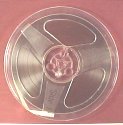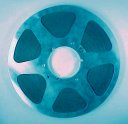Old Recordings Discs Tapes Wires Dictation Belts Other Media
|
Tape was first marketed in the U.S. in 1946 using a backing of either paper or acetate. Combinations of thinner, longer playing tapes and a new, plastic backing of polyester were introduced during the 1950s. Click here to see a list.

 Thinner bases made the tape more fragile, of consquence when restoring it- some break, some stretch. Many higher output tapes of the 1960s and 1970s developed squealing. These have to be carefully baked as the first processing step. Where acetate backed tape breaks under stress, polyester stretches. They can be told apart by holding a flat reel to an incandescent light. Light can be seen through the acetate, while the polyester is opaque. The two types may require different studio treatment. Short pieces of splicing tape used during the original editing sessions may have dried out which allows the tape to separate during winding today. They may have become sticky instead, adhering to an adjacent tape strand which pulls it, introducing a moment of pitch instability. Either problem means the old splices have to be replaced and residue removed before the tape can be copied. An unrecordable leader tape was customarily affixed to the reel ends. Specific lengths were also used as a timing strip between selections within the reel. This may or may not have to be removed and replaced with new leader and splices before a tape can be copied. Warped tape can often be flattened out but requires some studio and some storage time. This problem is more audibly severe with music than speech. BASIC LEVEL. Tape which does not require splice replacement and in otherwise good condition costs 1.5 to 2 times the playing time to prepare for copying tro a CD. Thus a one hour program runs between $ 150 and $ 200. Splice removal and replacement, if required, will increase studio time. ADDITIONAL SERVICES: See squealing tape for tape baking charges. I can either fix squealing tape it or return it to you but I can't work on it unless it has been baked. Should this process become necessary before further work can proceed, I'll notify you before continuing. Further editing and cleanup is at $ 100 per studio hour. We only work on quarter inch wide tapes except for tape baking. COPYING. Making your CD or cassette copy from the restored signal including assembling the selections into a playing sequence is $ 30 for the first CD or cassette, $ 20 for each thereafter.
This site ©2001 Steven Smolian. Rev 1 |
